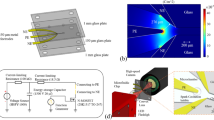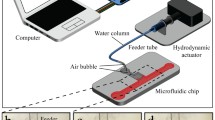Abstract
This paper presents a study of bubble dynamics in a resonator-shaped microfluidic chamber, including the bubble generation, radial oscillation and translation. The microfluidic chamber is incorporated with a piezoelectric actuator as part of the chamber wall, and DI-water is pumped throughout the chamber. Our experiments show that under the actuation at 1 kHz, the bubbles are generated, starting near the center of the chamber, growing up in size and even moving upstream against the main flow. Such type of bubble generation is different from those conventional bubble generations in microchannels by introducing external gas or laser radiation, and the bubble dynamics presented in this study is different from existing studies focusing on high-frequency actuations. To interpret our experimental findings, both numerical simulations and analytical modeling are conducted for studying the bubble dynamics in the low-frequency actuation case. The results show that the bubble generation and oscillations are due to the high-amplitude pressure fluctuations inside the chamber, corresponding to the actuations. Specifically, under the low-frequency actuation, the primary Bjerknes force becomes insignificant and the bubble translation against the main flow is attributed to the chamber sidewall attracting effect on the bubbles.












Similar content being viewed by others
References
Akhatov I, Mettin R, Ohl CD, Parlitz U, Lauterborn W (1997) Bjerknes force threshold for stable single bubble sonoluminescence. Phys Rev E 55:3747–3750
Brujan EA, Matsumoto Y (2012) Collapse of micrometer-sized cavitation bubbles near a rigid boundary. Microfluid Nanofluid 13:957–966
Chung SK, Cho SK (2009) 3-D manipulation of millimeter- and micro-sized objects using an acoustically excited oscillating bubble. Microfluid Nanofluid 6:261–265
Cole RH (1948) Underwater explosions. Princeton University Press, Clinton
Cosgrove D (2006) Ultrasound contrast agents: an overview. Eur J Radiol 60:324–330
Crum L, Eller A (1970) Motion of bubbles in a stationary sound field. J Acoust Soc Am 48:181–189
Doinikov AA (2002) Translational motion of a spherical bubble in an acoustic standing wave of high intensity. Phys Fluids 14:1420–1425
Espinoza BF, Zenit R, Legendre D (2008) The effect of confinement on the motion of a single clean bubble. J Fluid Mech 616:419–443
Hashmi A, Heiman G, Yu G, Lewis M, Kwon HJ, Xu J (2013) Oscillating bubbles in teardrop cavities for microflow control. Microfluid Nanofluid 14:591–596
Jung JY, Kwak HY (2007) Fabrication and testing of bubble powered micropumps using embedded microheater. Microfluid Nanofluid 3:161–169
Lauterborn W, Kurz T (2010) Physics of bubble oscillations. Rep Prog Phys 73:106501
Leighton TG (1994) The acoustic bubble. Academic Press, London
Liu Y, Sugiyama K, Takagi S, Matsumoto Y (2012) Surface instability of an encapsulated bubble induced by an ultrasonic pressure wave. J Fluid Mech 691:315–340
Louisnard O, Garcia JG (2011) Ultrasound technologies for food and bioprocessing. Springer, New York
Luo C, Huang XY, Nguyen NT (2007) Generation of shock free pressure waves in shaped resonators by boundary driving. J Acoust Soc Am 121:2515–2521
Matula TJ (1999) Inertial cavitation and single–bubble sonoluminescence. Phil Trans R Soc Lond A 357:225–249
Neppiras EA (1980) Acoustic cavitation thresholds and cyclic processes. Ultrasonics 18:201–209
Patrascioiu A, Fernandez-Pradas JM, Palla-Papavlu A, Morenza JL, Serra P (2014) Laser-generated liquid microjets: correlation between bubble dynamics and liquid ejection. Microfluid Nanofluid 16:55–63
Peng S, Nagarkar SP, Lowen JL, Velankar SS (2013) Circuit model for microfluidic bubble generation under controlled pressure. Microfluid Nanofluid 15:797–805
Plesset MS (1977) Bubble dynamics and cavitation. Ann Rev Fluid Mech 9:145–185
Plesset MS, Calif P (1949) The dynamics of cavitation bubbles. J Appl Mech 16:277–282
Prosperetti A (1977) Thermal effects and damping mechanisms in the forced radial oscillations of gas bubbles in liquids. J Acoust Soc Am 61:17–27
Quinto-Su PA, Lim KY, Ohl CD (2009) Cavitation bubble dynamics in microfluidic gaps of variable height. Phys Rev E 80:047301
Rayleigh L (1917) On the pressure developed in a liquid during the collapse of a spherical cavity. Philos Mag 34:94–98
Reddy AJ, Szeri AJ (2002) Coupled dynamics of translation and collapse of acoustically driven microbubbles. J Acoust Soc Am 112:1346–1352
Segers T, Versluis M (2014) Acoustic bubble sorting for ultrasound contrast agent enrichment. Lab Chip 14:1705–1714
Suslov SA, Ooi A, Manasseh R (2012) Nonlinear dynamic behavior of microscopic bubbles near a rigid wall. Phys Rev E 85:066309
Tandiono Ohl SW, Ow DSW, Klaseboer E, Wong VV, Dumke R, Ohl CD (2011) Sonochemistry and sonoluminescence in microfluidics. Proc Natl Acad Sci 108:5996–5998
Timshenko S, Krieger SW (1959) Theory of Plates and Shells. McGrall-Hill, New York
Vuong VQ, Szeri AJ (1996) Sonoluminescence and diffusive transport. Phys Fluids 8:2354–2364
Wang SS, Jiao ZJ, Huang XY, Yang C, Nguyen NT (2009) Acoustically induced bubbles in a microfluidic channel for mixing enhancement. Microfluid Nanofluid 6:847–852
Wang SS, Huang XY, Yang C (2011) Mixing enhancement for high viscous fluids in a microfluidic chamber. Lab Chip 12:2081–2087
Wang C, Rallabandi B, Hilgenfeldt S (2013) Frequency dependence and frequency control of microbubble streaming flows. Phys Fluids 25:022002
Acknowledgments
This project is funded by the Ministry of Education, Singapore. Xiaopeng Shang gratefully acknowledges the PhD research scholarship from Nanyang Technological University, Singapore.
Author information
Authors and Affiliations
Corresponding author
Electronic supplementary material
Below is the link to the electronic supplementary material.
Appendices
Appendix 1: numerical simulation using Ansys Fluent
A three-dimensional numerical simulation has been conducted by using the commercial software Ansys Fluent, to study pressure distribution in the microfluidic chamber. The computation domain for the numerical simulation is identical to that used in experiments, and the dimensions and meshes are shown in Fig. 13. There are 25 layers of meshes along the channel height, and the meshing is specifically refined inside the chamber and at the Y junction. Under the assumptions of incompressible, Newtonian fluid, the governing equations of continuity and momentum are expressed as
where \(\overset{\lower0.5em\hbox{$\smash{\scriptscriptstyle\rightharpoonup}$}} {V}\) is the velocity vector, p the pressure, ρ the density and υ the kinetic viscosity.
The bottom wall with PZT disk is set as a moving boundary, and the top wall is stationary. The vibration of the PZT disk is described by the displacement ζ(x, y, t) (Timshenko and Krieger 1959)
where the amplitude of vibration A 0 is 0.22 μm, the frequency imposed to the PZT disk f is 1.0 kHz, and R chamb is radius of the chamber, which is 8 mm in our experiment. All the boundary conditions are listed in Table 1. Based on a mesh independence study, it is found that the meshing scheme with 877,296 cells in total is sufficient for our simulations.
Appendix 2: the analytical model and detailed calculations
The model for a bubble between two intersected walls is illustrated in Fig. 14a, together with the coordinate system. The image system which satisfies the boundary condition at the rigid walls is illustrated in Fig. 14b. There are 2n − 1 image bubbles in total, where n = 180/2α (n is an integer). R and x denote the time-dependent radius and displacement, respectively, the variables with dots corresponding to the time derivatives, and d i is the distance between the real bubble and the ith image bubble. Local coordinates, (r, θ) and (r i , θ i ), are located at the center of the real bubble and ith image bubbles, respectively. The velocity potential in response to the actuation in the model is defined as
where R and x with dots are the corresponding time derivatives for the bubble’s radius and displacement, respectively, Φr is the unit potential for bubble radial motion and Φx is the unit potential for bubble translational motion.
The velocity potential from the bubble radial pulsation of unit strength is obtained by the superposition of contributions from all bubbles, including the real one and its images, i.e.
where \(\phi^{r}\) is the velocity potential corresponding to the real bubble, and \(\phi_{i}^{r}\) is the velocity potential responding to the ith image bubble. The velocity potential from the bubble translation of unit strength is obtained by the superposition of contributions from all bubbles, including the real one and images, i.e.
where \(\phi^{x}\) is the velocity potential for the real bubble, and \(\phi_{i}^{x}\) is the velocity potential for the ith image. ξ and ξ i , are the coordinate angles denoted in Fig. 14b. The kinetic energy T, associated with the motions (including pulsation and translation) of all bubbles, is written as
The first integral in Eq. 13 can be calculated by substituting the potential Eq. 11 into the integral and evaluating it over the real bubble surface. The integration, denoted as I 1, gives
where \(\frac{1}{{D_{1} }} = \sum\nolimits_{i = 1}^{n - 1} {\frac{2}{{d_{i} }}} + \frac{1}{{d_{n} }}\).
By substituting the velocity potential Eq. 12 into the second and third integrals in Eq. 13, the two integrals, denoted as I 2 and I 3, can then be obtained by evaluating integrals over the real bubble surface,
In Eq. 15 and 16, \(\frac{1}{{D_{2} }} = \sum\nolimits_{i = 1}^{n - 1} {\frac{2\sin i\alpha }{{d_{i}^{2} }} + } \frac{1}{{d_{n}^{2} }}\) and \(\frac{1}{{D_{3} }} = \sum\nolimits_{i = 1}^{n - 1} {\frac{{\sin^{2} i\alpha + 1}}{{d_{i}^{3} }}} + \frac{1}{{d_{n}^{3} }}\).
The kinetic energy T can therefore be given as
The potential energy U of the liquid is calculated by
where V b is the time-dependent volume of the bubble, P 1 is the pressure at the surface of the real bubble and the drag force on the bubble, F ex, is calculated by \(F_{\text{ex}} = - 12\pi \mu_{\text{eff}} R\dot{x}\) (Doinikov 2002). The Lagrangian L can be obtained by the kinetic energy T and potential energy U,
By substituting the Eq. 19 into the Lagrangian equation
and carrying out the differentiations with respect to the generalized coordinates R and x, the governing equations Eqs. 7a and 7b for the bubble translation are derived. In the calculations, the scattered pressure at the surface of the real bubble P 1 is defined by \(P_{1} = P_{\text{g}} + P_{\text{v}} - \frac{2\sigma }{R} - \frac{{4\mu_{\text{eff}} \dot{R}}}{R} - P_{\infty }\), where P g is the partial pressure of gas inside the bubble, P v the vapor pressure, σ the surface tension, and μ eff the effect viscosity. The pressure actuations applied at infinity is, \(P_{\infty } = P_{0} - P_{\text{a}} \sin (2\pi ft)\), where P 0 is the ambient pressure, P a is the pressure fluctuation amplitude, and f is the actuation frequency. P a is set as 0.93 P 0 (Doinikov 2002). The effective viscosity μ eff consists of the thermal damping μ t and fluid viscous damping μ (Prosperetti 1977). All the parameters in the model are listed in Table 2.
Rights and permissions
About this article
Cite this article
Shang, X., Huang, X. & Yang, C. Bubble dynamics in a microfluidic chamber under low-frequency actuation. Microfluid Nanofluid 20, 14 (2016). https://doi.org/10.1007/s10404-015-1681-2
Received:
Accepted:
Published:
DOI: https://doi.org/10.1007/s10404-015-1681-2






